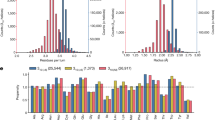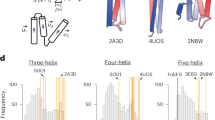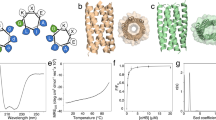Abstract
We have designed de novo a simple, context-free, model linear peptide system to fold into a regular β-hairpin structure, with three-residue β-strands connected by a type 1' β-turn. CD and NMR analysis of this peptide in aqueous solution show that the peptide folds into the expected conformation. Structural characterization of three peptide variants, in which some of the strand side-chains have been substituted by alanine, demonstrates that inter-strand side chain–side chain interactions are essential for β-hairpin formation. This simple model system will help to isolate the factors behind β-sheet formation, and contribute useful information about de novo protein design.
This is a preview of subscription content, access via your institution
Access options
Subscribe to this journal
Receive 12 print issues and online access
$189.00 per year
only $15.75 per issue
Buy this article
- Purchase on Springer Link
- Instant access to full article PDF
Prices may be subject to local taxes which are calculated during checkout
Similar content being viewed by others
References
Zimm, B.H. & Bragg, J.K. Theory of the phase transition between helix and random coil. J. Chem. Phys. 31, 526 (1959).
Lifson, R. & Roig, A. On theory of helix-coil transitions in biopolymers. J. Chem. Phys. 34, 1963–1974 (1961).
Brown, J.E. & Klee, W.A. Helix-coil transition of the isolated amino terminus of ribonuclease. Biochemistry, 10, 470–476 (1971).
Chakrabartty, A. & Baldwin, R.L. Stability of α-helices. Adv. Prot Chem. 46, 141–177 (1995).
Muñoz, V. & Serrano, L. Elucidating the folding problem of helical peptides using empirical parameters. Nature Struct. Biol. 1, 399–409 (1994).
Minor, Jr., D.L. & Kim, P.S. Measurement of the β-sheet propensities of amino acids. Nature 367, 660–663 (1994).
Minor, Jr., D.L. & Kim, P.S. Context is a major determinant of β-sheet propensity. Nature 371, 264–267 (1994).
Smith, C.K. & Regan, L. Guidelines for protein design: The energetics of β sheet side chain interactions. Science 270, 980–982 (1995).
Ptitsyn, O.B. Protein folding: General physical model. FEBS Lett. 131, 197–201 (1981).
Dyson, H.J. & Wright, P.E. Defining solution conformations of small linear peptides. Annu. Rev. Biophys. Biophys. Chem. 20, 519–538 (1991).
Blanco, F.J., Rivas, G. & Serrano, L. A short linear peptide that folds into a native stable β-hairpin in aqueous solution. Nature Struct. Biol. 1, 584–590 (1994).
Kobayashi, N., Yoshii, H., Murakami, T. & Munekata, E. Study on the folding of immunoglobulin binding protein, streptococcal protein G in aqueous solution. Peptide Chem. 313–316 (1994).
Blanco, F.J. et al. Evidence of a short linear peptide that folds into a native stable β-hairpin in aqueous solution. J. Am. Chem. Soc. 115, 5887–5888 (1993).
Alba de, E., Blanco, F.J., Jiménez, M.A., Rico, M. & Nieto, J.L. Interactions responsible for the β-hairpin conformational population formed by a designed linear peptide. Eur. J. Biochem. 233, 283–292 (1995).
Searle, M.S., Williams, D.H. & Packman, L.C. A short linear peptide derived from the N-terminal sequence of ubiquitin folds into a water-stable non-native β-hairpin. Nature Struct. Biol. 2, 999–1006 (1995).
Sibanda, B.L. & Thornton, J.M. β-hairpin families in globular proteins. Nature 316, 170–174 (1985).
Smith, C.K., Withka, J.M. & Regan, L. A thermodynamic scale for the β-sheet forming tendencies of the amino acids. Biochemistry 33, 5510–5517 (1994).
Kim, C.A. & Berg, J.M. Thermodynamic β-sheet propensities measured using a zinc-finger host peptide. Nature 362, 267–270 (1993).
Wouters, M.A. & Curmi, P.M.G. An analysis of side chain interactions and pair correlations within anti parallel β-sheets: the differences between backbone hydrogen-bonded and non-hydrogen-bonded residue pairs. Prot. Struct. Funct. Genet. 22, 119–131 (1995).
Vriend, G. WHATIF: A molecular modelling and drug design program. J. molec. Graph. 8, 52–56 (1990).
Hutchinson, E.G. & Thornton, J.M. A revised set of potentials for β-turn formation in proteins. Prot. Sci. 3, 2207–2216 (1994).
Muñoz, V. & Serrano, L. Intrinsic secondary structure propensities of the amino acids, using statistical Φ-ψ matrices: comparison with experimental results. Prot. Struct. Funct. Genet. 20, 301–311 (1994).
Richardson, J.S. The anatomy and taxonomy of protein structure. Adv. Prot. Chem. 34, 167–339 (1981).
Johnson, Jr., W.J. Secondary structure of proteins through circular dichroism spectroscopy. Ann. Rev. Biophys. Biophys. Chem. 17, 145–166 (1988).
Merutka, G., Dyson, H.J. & Wright, P.E. ‘Random coil’ 1H chemical shifts obtained as a function of temperature and trifluoroethanol concentration for the peptide series GGXGG. J. Biomol. NMR 5, 14–24 (1995).
Williamson, M.P. Secondary-structure dependent chemical shifts in proteins. Biopolymers 29, 1423–1431 (1990).
Serrano, L. Comparison between the Φ distribution of the amino acids in the protein database and NMR data indicates that amino acids have various Φ propensities in the random coil conformation. J. Molec. Biol. 254, 322–333 (1995).
Smith, L.J. et al. Analysis of main chain torsion angles in proteins. Prediction of NMR coupling constants for native and random-coil conformations. J. Molec. Biol. 255, 494–506 (1996).
Chothia, C. Conformation of twisted β-pleated sheets in proteins. J. Molec. Biol. 75, 295–302 (1973).
Rose, G.D., Gierasch, L.M. & Smith, J.A. Turns in peptides and proteins. Adv. Prot. Chem. 37, 1–105 (1985).
Blanco, F.J. et al. NMR solution structure of the isolated N-terminal fragment of protein-G B1 domain. Evidence of trifluoroethanol induced native-like β-hairpin formation. Biochemistry 33, 6004–6014 (1994).
Yang, A. & Honig, B. Free energy determinants of secondary structure formation: II. anti parallel β-sheets. J. Molec. Biol. 52 366–376 (1995).
Wilmot, C.M. & Thornton, J.M. Analysis and prediction of the different types of β-turns in proteins. Molec. Biol. 203 221–232 (1988).
Sibanda, B.L., Blundell, T.L. & Thornton, J.M. Conformation of β-hairpins in protein structures. A systematic classification with applications to modelling by homology, electron density fitting and protein engineering. Molec. Biol. 206 759–777 (1989).
Hobohm, U., Scharf, M., Schneider, R. & Sander, C. Selection of representative protein datasets. Prot. Sci. 1, 409 (1992).
Kabsch, W. & Sander, C. Dictionary of protein secondary structure: Pattern recognition of hydrogen-bonded and geometrical features. Biopolymers 22, 2577–2637 (1983).
Gill, S.C. & von Hippel, P.H. Calculation of protein extinction coefficients from amino acid sequence data. Anal. Biochem. 182, 319–326 (1989).
Wüthrich, K. NMR of proteins and nucleic acids. (John Wiley and Sons, New York, 1986).
Güntert, P., Braun, W. & Wüthrich, K. Improved efficiency of protein structure calculations from NMR using the program DIANA with redundant dihedral angle constraints. J. Molec. Biol. 217, 517–530 (1991).
Pearlman, D.A. et al. AMBER 4.1 (University of California, San Francisco, 1995).
Mcdonald, I., Naylor, D., Jones, D. & Thornton, J. HBPLUS (Department of Biochemistry and Molecular Biology, University College, London, 1993).
Karplus, M. Contact electron-spin coupling of nuclear magnetic moments. J. Phys. Chem. 30, 11–15 (1959).
Viguera, A.R. & Serrano, L. Side-chain interactions between sulfur containing amino acids and phenylalanine in α-helices. Biochemistry 34, 8771–8779 (1995).
Author information
Authors and Affiliations
Rights and permissions
About this article
Cite this article
Ramírez-Alvarado, M., Blanco, F. & Serrano, L. De novo design and structural analysis of a model β-hairpin peptide system. Nat Struct Mol Biol 3, 604–612 (1996). https://doi.org/10.1038/nsb0796-604
Received:
Accepted:
Issue Date:
DOI: https://doi.org/10.1038/nsb0796-604
This article is cited by
-
Diversity in αβ and βα Loop Connections in TIM Barrel Proteins: Implications for Stability and Design of the Fold
Interdisciplinary Sciences: Computational Life Sciences (2018)
-
The role of sodium ions in the solubility of peptides
Structural Chemistry (2016)
-
Separation of peptide fragments of a protein kinase C substrate fused to a β-hairpin by capillary electrophoresis
Analytical and Bioanalytical Chemistry (2015)
-
Effect of charged amino acid side chain length on lateral cross-strand interactions between carboxylate- and guanidinium-containing residues in a β-hairpin
Amino Acids (2015)
-
Proline-glutamate chimera’s side chain conformation directs the type of β-hairpin structure
Amino Acids (2014)



